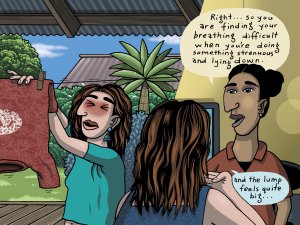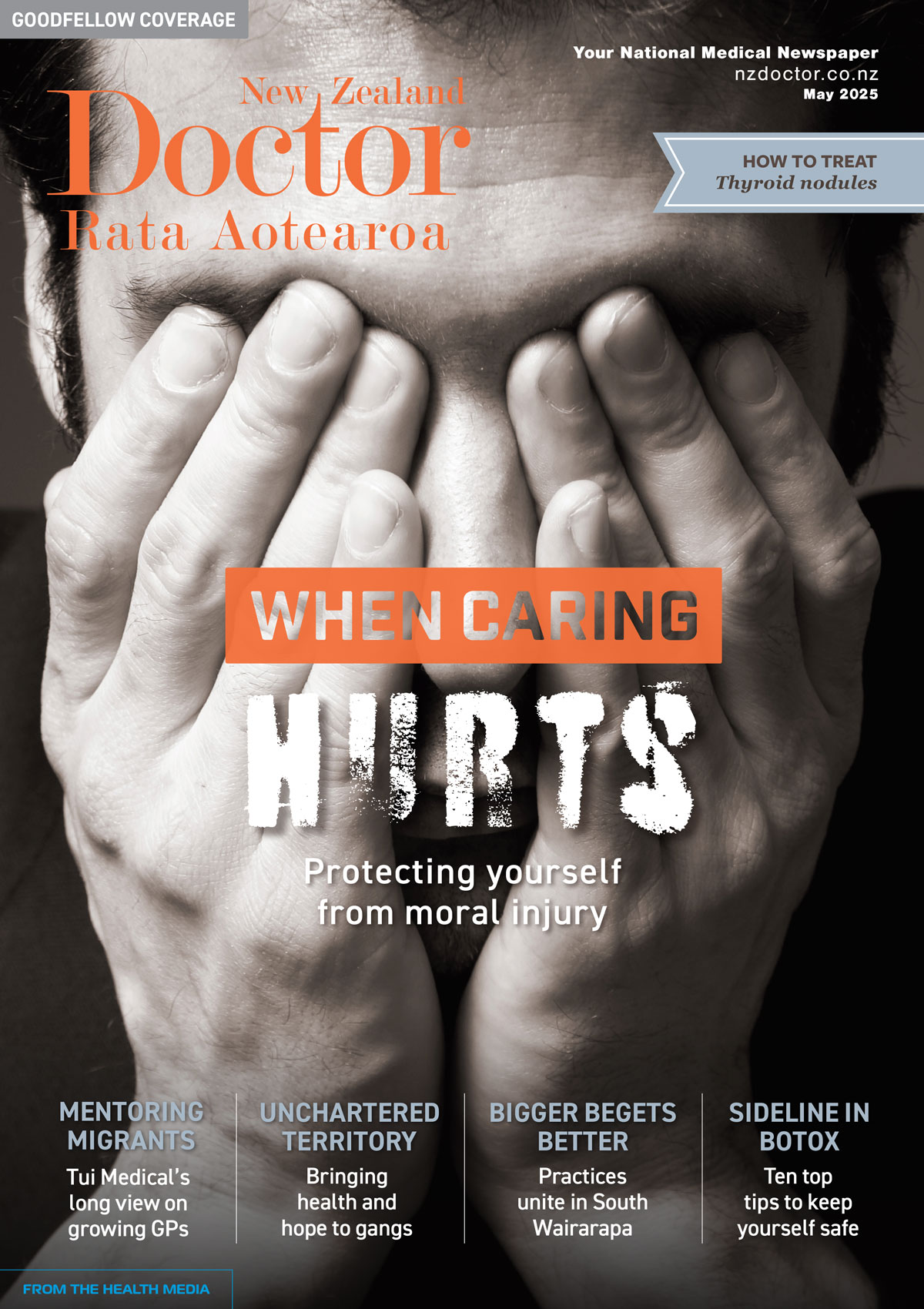Otolaryngologist, head and neck surgeon Francis T. Hall discusses the evaluation of thyroid nodules, which primarily aims to determine the likelihood of malignancy. He then reviews the treatment of thyroid nodules and thyroid cancer, including recent advances in management
Imagine all the people, imagine again - Seeking a source for the community voice
Imagine all the people, imagine again - Seeking a source for the community voice

POLICY PUZZLER
Tim Tenbensel grapples with the question of how to find the mythical ‘community’ voice that is so often quoted in health policy; be it patient, public, consumer or citizen
- Is the main purpose of lay involvement in health to give greater legitimacy to decisions, or is it to facilitate more effective health services?
- The “lay” voice is arguably most effective when it is based in real, local organisations that have strong linkages across their communities.
- Māori and Pacific providers tend to be organisations that take their commitment to the lay voice most seriously.
As a good Catholic boy growing up in the 1970s and 1980s, I remember lots of talk about the importance of the “laity” in the life of the Catholic Church.
It’s a word that has always intrigued me, because it is one of those words that can only be understood in terms of what it isn’t, rather than what it is. In the religious context, laity meant anyone other than the clergy.
I see many strong parallels with more recent ideas about the governance of the health sector. But the big difference is that there is no equivalent word to “laity” to denote “all those who are not clinicians or health service managers”.
In the current health reform process, the Government has signalled its intention to embed the consumer voice into the new health system structures. (FIX: Building consumer voices into the reformed health system, nzdoctor.co.nz, 5 August.)
The Health Quality & Safety Commission’s consumer engagement programme, He Hoa Tiaki, states that “consumers should be actively involved in decision-making about health and disability services at every level – including governance, planning, policy, setting priorities and highlighting quality issues.”
In health, there is a plethora of terms which are often used interchangeably. At first glance it appears that the various calls for greater patient/community/public/consumer/citizen involvement in health, all mean much the same thing – to enable the voice of the health laity to be heard. But a closer look reveals that there are many different ideas of who, exactly, should be more involved, for what purpose, at what scale and how.
Is the main purpose of lay involvement in health to give greater legitimacy to decisions, or is it to facilitate more effective health services? You might well answer – “isn’t it both?”, but political scientists and philosophers since Plato (at least) have pointed out that decision-making processes that widen inclusion might not lead to better results or services, however we might define these.
The justification for having elected members of district health boards was mainly about legitimacy – reinstating a long Kiwi tradition of local democratic input into health governance. But I can’t remember anyone ever claiming that elected members on DHBs resulted in more effective governance and implementation.
Each of the various terms used to denote the health laity, leads in quite different directions. For instance, “citizens” and “consumers” are quite different things. My interest as a consumer may be widening access to new medicines, whereas my interest as a citizen may be to have a system that is good value for money.
In fact, using phrases such as “the public” or “the community” or “the consumer voice” is often a bit of a fudge, particularly when there are no mechanisms in place for synthesising or aggregating the various, potentially conflicting perspectives within a community into a single voice or message.
Since the early 1990s, we have witnessed a number of new techniques of public or patient input – each with characteristic strengths and weaknesses.
Citizens’ juries were all the rage in the late 1990s in health. This was the idea that a jury made up of randomly selected citizens would hear expert evidence about a particular health topic or resource-allocation decision, deliberate on the evidence and come to a verdict. These were interesting experiments, but were very resourceintensive exercises that, in the end, only ever made recommendations, not decisions.
More recently, many health sector organisations have sought consumer representatives on boards or set up consumer advisory forums.
There is a wealth of experience developing here but many thorny issues typically raise their head. How is a community/consumer representative “selected”? How do they understand their role? Are the people who are selected for these roles usually drawn from the strata of society with high health literacy and who already benefit the most from the existing system?
Do consumer representatives have a constituency? Are they answerable to them? Is it a problem, or not, if those given the task of providing a public or patient voice become experts in “health-sector speak” that they begin to resemble and sound like the “clergy” rather than the laity?
Notwithstanding all these dilemmas and questions, there are patterns of better (and worse) practice that are becoming apparent.
The “lay” voice is arguably most effective, and also most legitimate, when it is based in real, local organisations that have strong linkages across their communities.
This contrasts with the many “imaginary communities” that are invented out of thin air in policy and strategic planning documents.
On the whole, lay input tends to have more impact on the actual design of services, rather than in more abstract, strategic decision-making and planning. This is partly an issue of scale. The larger the population, the more imaginary the community.
Community representation on PHO boards also works best when strong linkages with local communities are present. This is more likely when providers have arisen directly from local community responses to gaps in the health system, and Māori and Pacific providers are the best current examples of this dynamic.
These providers continually wrestle with the question of how they relate to their communities, in a world in which they are enmeshed in contract negotiations with funders, service specifications, and employment of health professionals. These tend to be the organisations that take their commitment to the lay voice most seriously, and other health sector organisations have a lot that they can learn from them.
From what I can gather from a distance, the laity now run most of the core Catholic institutions including schools and local parishes, and a major reason for that is the shrinking clergy. Even though health’s clergy is far less likely to shrink, we may be witnessing a similar movement in health. It is more likely to emerge from local necessity than grand design.
Tim Tenbensel is associate professor, health policy, in the School of Population Health at the University of Auckland
We've published this article as a FREE READ so it can be read and shared more widely. Please think about supporting us and our journalism – subscribe here




![Barbara Fountain, editor of New Zealand Doctor Rata Aotearoa, and Paul Hutchison, GP and senior medical clinician at Tāmaki Health [Image: Simon Maude]](/sites/default/files/styles/thumbnail_cropped_100/public/2025-03/Barbara%20Fountain%2C%20editor%20of%20New%20Zealand%20Doctor%20Rata%20Aotearoa%2C%20and%20Paul%20Hutchison%2C%20GP%20and%20senior%20medical%20clinician%20at%20T%C4%81maki%20Health%20CR%20Simon%20Maude.jpg?itok=-HbQ1EYA)
![Lori Peters, NP and advanced health improvement practitioner at Mahitahi Hauora, and Jasper Nacilla, NP at The Terrace Medical Centre in Wellington [Image: Simon Maude]](/sites/default/files/styles/thumbnail_cropped_100/public/2025-03/2.%20Lori%20Peters%2C%20NP%20and%20advanced%20HIP%20at%20Mahitahi%20Hauora%2C%20and%20Jasper%20Nacilla%2C%20NP%20at%20The%20Terrace%20Medical%20Centre%20in%20Wellington%20CR%20Simon%20Maude.jpg?itok=sUfbsSF1)
![Ministry of Social Development health and disability coordinator Liz Williams, regional health advisors Mary Mojel and Larah Takarangi, and health and disability coordinators Rebecca Staunton and Myint Than Htut [Image: Simon Maude]](/sites/default/files/styles/thumbnail_cropped_100/public/2025-03/3.%20Ministry%20of%20Social%20Development%27s%20Liz%20Williams%2C%20Mary%20Mojel%2C%20Larah%20Takarangi%2C%20Rebecca%20Staunton%20and%20Myint%20Than%20Htut%20CR%20Simon%20Maude.jpg?itok=9ceOujzC)
![Locum GP Helen Fisher, with Te Kuiti Medical Centre NP Bridget Woodney [Image: Simon Maude]](/sites/default/files/styles/thumbnail_cropped_100/public/2025-03/4.%20Locum%20GP%20Helen%20Fisher%2C%20with%20Te%20Kuiti%20Medical%20Centre%20NP%20Bridget%20Woodney%20CR%20Simon%20Maude.jpg?itok=TJeODetm)
![Ruby Faulkner, GPEP2, with David Small, GPEP3 from The Doctors Greenmeadows in Napier [Image: Simon Maude]](/sites/default/files/styles/thumbnail_cropped_100/public/2025-03/5.%20Ruby%20Faulkner%2C%20GPEP2%2C%20with%20David%20Small%2C%20GPEP3%20from%20The%20Doctors%20Greenmeadows%20in%20Napier%20CR%20Simon%20Maude.jpg?itok=B0u4wsIs)
![Rochelle Langton and Libby Thomas, marketing advisors at the Medical Protection Society [Image: Simon Maude]](/sites/default/files/styles/thumbnail_cropped_100/public/2025-03/6.%20Rochelle%20Langton%20and%20Libby%20Thomas%2C%20marketing%20advisors%20at%20the%20Medical%20Protection%20Society%20CR%20Simon%20Maude.jpg?itok=r52_Cf74)
![Specialist GP Lucy Gibberd, medical advisor at MPS, and Zara Bolam, urgent-care specialist at The Nest Health Centre in Inglewood [Image: Simon Maude]](/sites/default/files/styles/thumbnail_cropped_100/public/2025-03/7.%20Specialist%20GP%20Lucy%20Gibberd%2C%20medical%20advisor%20at%20MPS%2C%20and%20Zara%20Bolam%2C%20urgent-care%20specialist%20at%20The%20Nest%20Health%20Centre%20in%20Inglewood%20CR%20Simon%20Maude.jpg?itok=z8eVoBU3)
![Olivia Blackmore and Trudee Sharp, NPs at Gore Health Centre, and Gaylene Hastie, NP at Queenstown Medical Centre [Image: Simon Maude]](/sites/default/files/styles/thumbnail_cropped_100/public/2025-03/8.%20Olivia%20Blackmore%20and%20Trudee%20Sharp%2C%20NPs%20at%20Gore%20Health%20Centre%2C%20and%20Gaylene%20Hastie%2C%20NP%20at%20Queenstown%20Medical%20Centre%20CR%20Simon%20Maude.jpg?itok=Z6u9d0XH)
![Mary Toloa, specialist GP at Porirua and Union Community Health Service in Wellington, Mara Coler, clinical pharmacist at Tū Ora Compass Health, and Bhavna Mistry, specialist GP at Porirua and Union Community Health Service [Image: Simon Maude]](/sites/default/files/styles/thumbnail_cropped_100/public/2025-03/9.%20Mary%20Toloa%2C%20Porirua%20and%20Union%20Community%20Health%20Service%20in%20Wellington%2C%20Mara%20Coler%2C%20T%C5%AB%20Ora%20Compass%20Health%2C%20and%20Bhavna%20Mistry%2C%20PUCHS%20CR%20Simon%20Maude.jpg?itok=kpChr0cc)